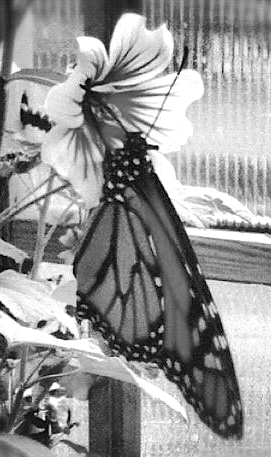

orange, black, and white wings.
Photo Credit / Lyssa Ellis
By Briana Magistro
SC Staff Writer
Although it’s still cold outside, it’s time to start thinking spring! Floating into this week’s “Animal of the Issue” is the highly recognizable Monarch butterfly.
These pretty bugs reside in the order Lepidoptera, which houses all moths and butterflies, and the family Nymphalidae, which includes brush-footed butterflies.
According to ESU’s entomologist Dr. Wallace, “Nymphalids are extremely colorful.”
Other examples within this family are the California Tortoiseshell butterfly and the Meadow Brown butterfly, which exhibits large yellow eyespots on its wings to deter predators.
The Monarch butterfly is bright orange and black in color, with white spots on the tips of its wings. Males are slightly larger and can sport additional patches of black.
In some populations, males have been observed with gray coloration instead of orange. In isolated populations, such as those on islands, the percentage of gray males is typically higher.
Milkweed is the Monarch butterfly’s favorite food. It is also the preferred location for laying eggs, and it is very important to a population’s success.
Butterflies have long tongues that they stick down into flowers to suck up the nectar. They keep their tongues rolled up when not in use.
Monarchs help in the process of pollination, like bees and hummingbirds. Pollen from flowers sticks to the butterfly’s legs and is carried from flower to flower.
Monarch butterflies are found in North America, Australia, and Europe. The North American populations migrate, and thus have longer wings than average.
“Monarchs migrate to California and Mexico in the fall. They are escaping the cold and lack of food of the winter climate in temperate North America,” said Dr. Wallace.
Butterflies in the eastern half of the US migrate to Mexico, while western populations migrate to the Californian coasts. This is an extraordinarily long adventure for these insects.
Dr. Wallace commented, “Individuals then return north and east in the spring — they are the only butterflies known to have a two-way migration like birds.”
Breeding occurs in the spring, when there are plenty of milkweeds. Unlike most other butterflies, Monarch butterflies do not rely on pheromones, or attractive scent hormones, to attract a mate.
Females can be quite picky when choosing a mate.
“A female may reject numerous males before she mates,” Dr. Wallace said. The number of eggs laid depends on how many mates the mother had.
All butterflies have three life stages — a larval form, a pupa form, and an adult form. After hatching, butterfly larva, also known as caterpillars, eat as much food as they can in order to store nutrients for their pupa, or cocoon, stage.
Monarch caterpillars are black with yellow and white stripes.
They molt several times before creating their cocoons. Each molting represents a growth cycle for the caterpillars.
Monarchs reside in their cocoons for about two weeks before emerging as butterflies. It can take hours before they are ready to fly.
Monarch butterflies have great defense systems throughout their life cycles. As a caterpillar, they exhibit bright colors. In nature, bright colors typically signify poison or foul taste.
Caterpillars also feed mostly on milkweed. Milkweed contains substances called cardiac glycosides, compounds that are toxic to almost all other organisms.
Caterpillars accumulate as much of these toxins as possible and store them through adulthood.
Adult butterflies mimic the appearance of the Vicery butterfly, a poisonous insect. The main difference between these two species is the length of the first set of legs. In Monarchs, they are very short.
Although Monarch butterflies have many ways to keep predators away, they can still be attacked by larger birds, which can withstand the toxins. Some birds have even developed immunities.
There are also parasites, like mites, that feed on caterpillars or cocoons.
Within the last twenty years, the Monarch butterfly population has decreased severely.
Dr. Wallace said, “Monarchs face several threats — loss of their larval food plant, milkweed, from herbicides and residential development, loss of their overwintering grounds due to deforestation, and possible larval mortality from eating pollen of genetically modified crops.”
Conservation specialists have been trying to get the Monarch butterfly on the endangered species list in order to enhance conservation efforts. Some conservation efforts include the commercial planting of milkweed and the reduced usage of destructive herbicides.
If you would like to help conserve this beautiful bug, plant milkweed in your garden. It will attract the butterfly and help its offspring to grow. Since it is toxic to other insects, it may even help keep some pests away!
Email Briana at:
bmagistro@live.esu.edu
